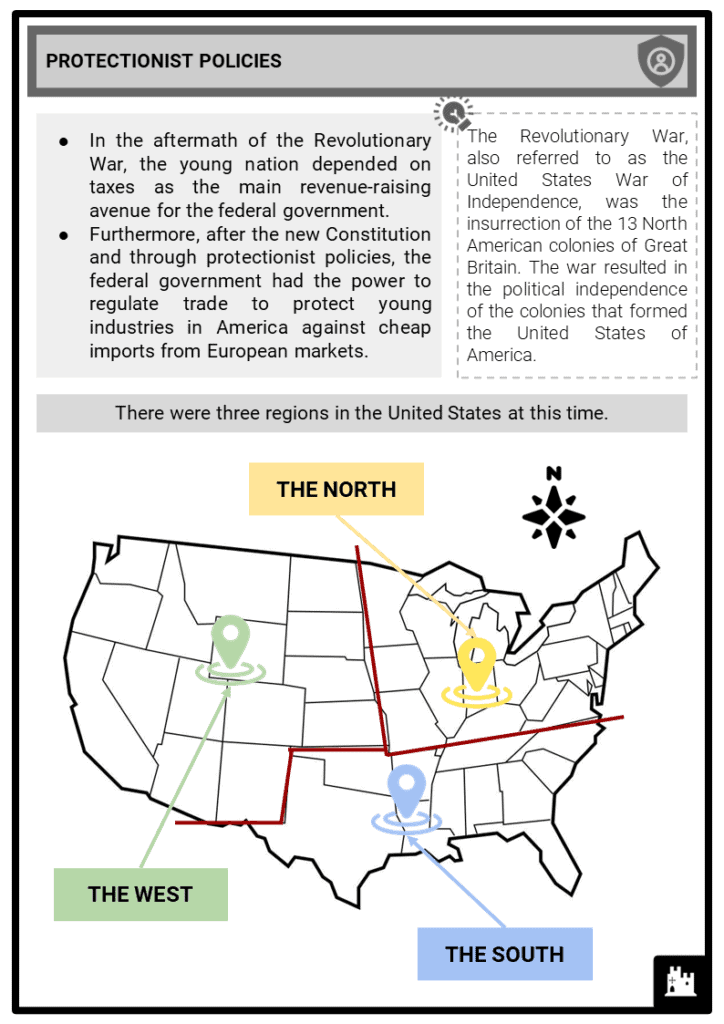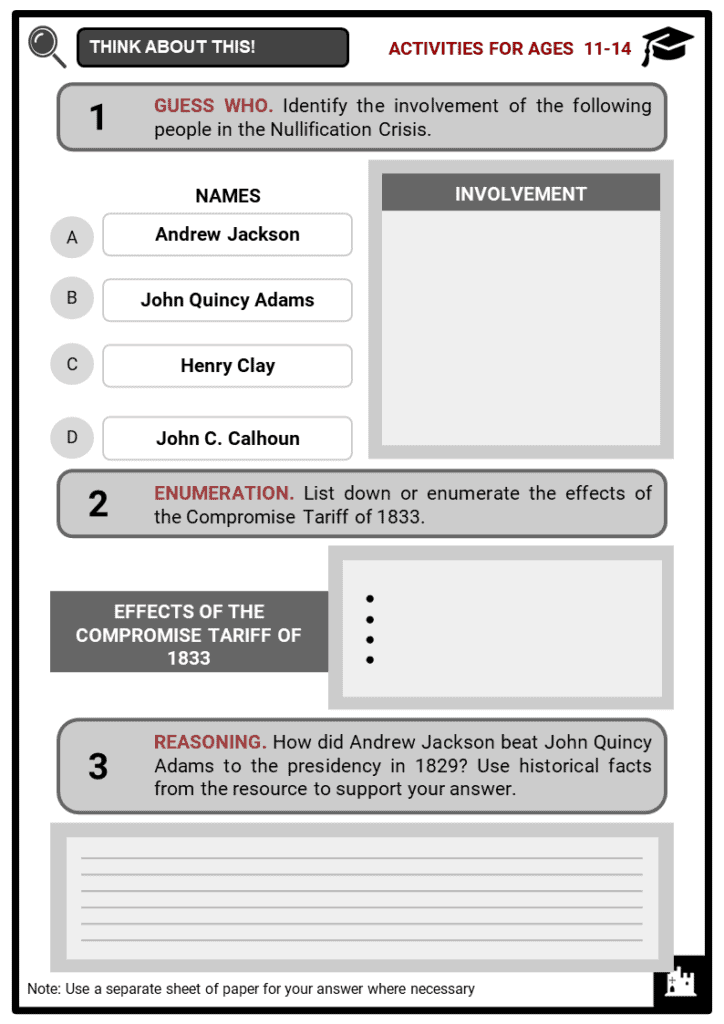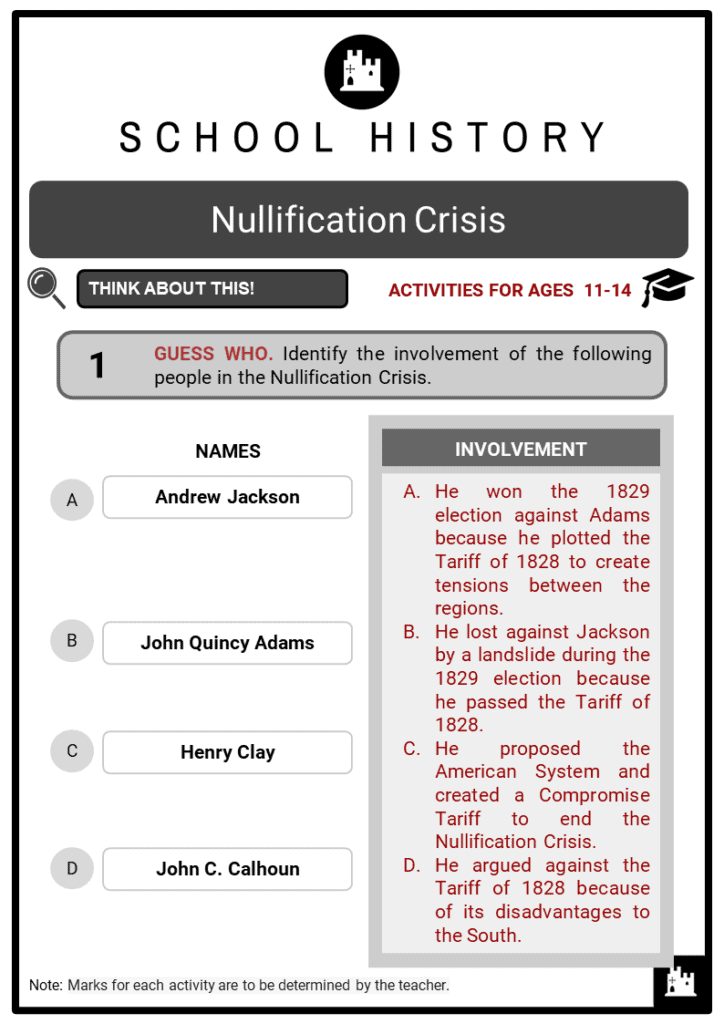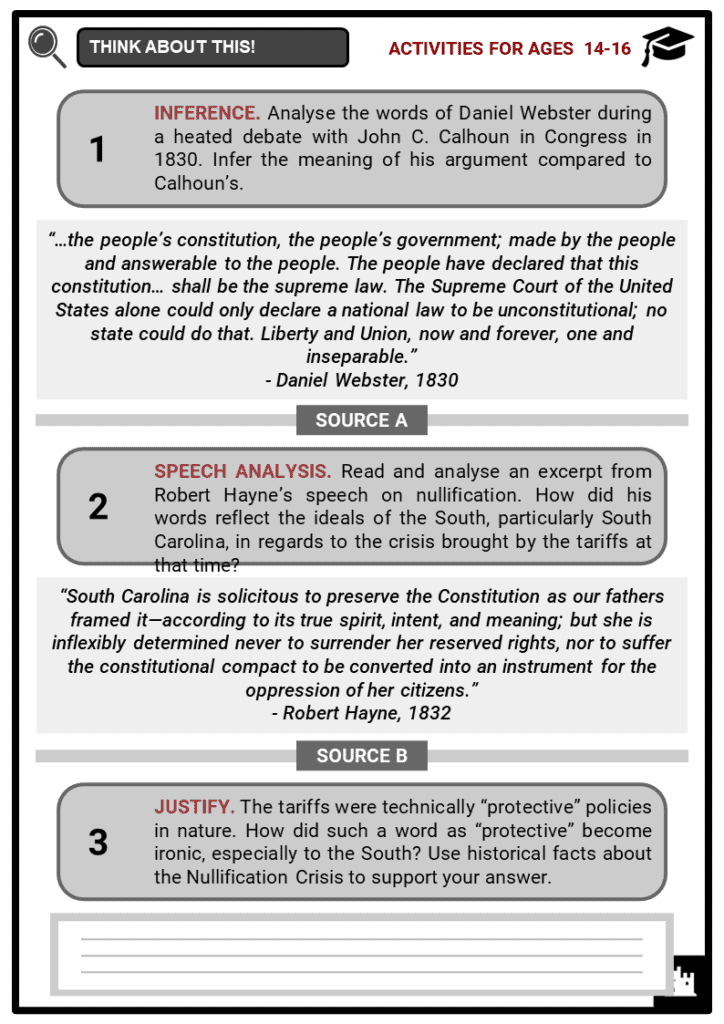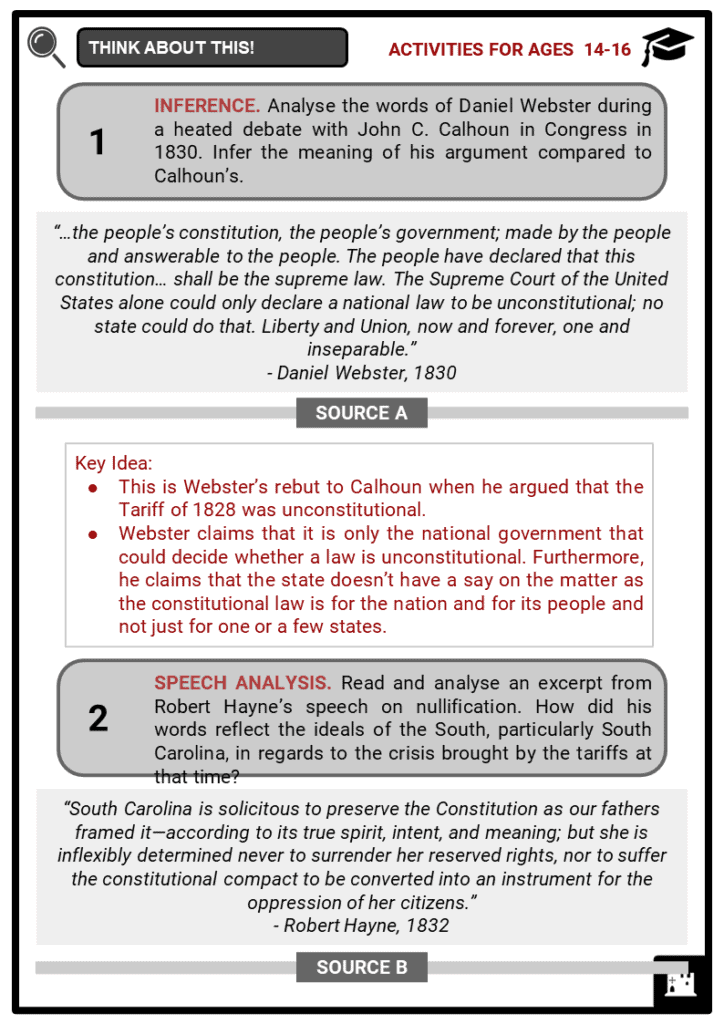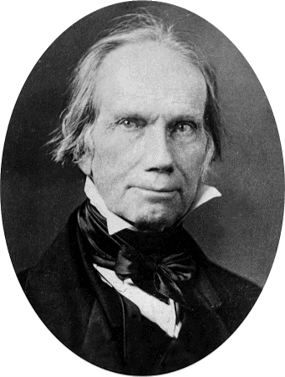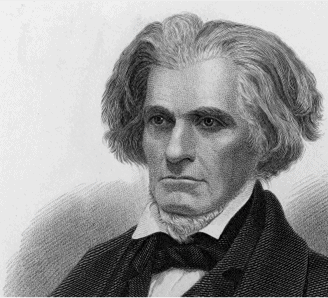Download Nullification Crisis Worksheets
Do you want to save dozens of hours in time? Get your evenings and weekends back? Be able to teach Nullification Crisis to your students?
Our worksheet bundle includes a fact file and printable worksheets and student activities. Perfect for both the classroom and homeschooling!
Table of Contents
Add a header to begin generating the table of contents
Summary
- The Protectionist Policies
- Henry Clay’s American System
- The Cause of the Nullification Crisis: The Tariff of Abominations
- The End of the Nullification Crisis: The Compromise Tariff of 1833
Key Facts And Information
Let’s know more about Nullification Crisis!
- The Nullification Crisis was the sectional political crisis in the United States from 1832 to 1833 that resulted in a confrontation between South Carolina and the federal government because of the disadvantages that the Tariff of 1828 brought to the southern states. John C. Calhoun conceptualised the nullification principle that provided for states to ignore or nullify federal laws that were detrimental to them or violated the Constitution. This Nullification Crisis is considered a precursor to the American Civil War.
Protectionist Policies
- In the aftermath of the Revolutionary War, the young nation depended on taxes as the main revenue-raising avenue for the federal government.
- Furthermore, after the new Constitution and through protectionist policies, the federal government had the power to regulate trade to protect young industries in America against cheap imports from European markets.
- The Revolutionary War, also referred to as the United States War of Independence, was the insurrection of the 13 North American colonies of Great Britain. The war resulted in the political independence of the colonies that formed the United States of America.
- There were three regions in the United States at this time.
- The North, whose people were predominantly manufacturers for the local southern and European markets. Protectionist policies were favourable to them because the taxes increased the cost of imported goods, making their products and prices more competitive.
- The second region was the slave-owning agriculturalists who depended on imports from the North and Europe and who mainly occupied the southern region.
- The West was the third region in America at the time. In the 1800s, it was still evolving - attracting settlers for reasons including the transcontinental railroad and the gold and silver rush.
- In 1829, Andrew Jackson was elected president with a landslide win against John Quincy Adams for two main reasons:
- The first was that his opponent, the immediate former president, was perceived to be unfairly elected and corrupt with an ineffectual presidency. Therefore, the majority of the people voting for Jackson were voting against Quincy.
- The second reason was that Jackson appealed to the ordinary person due to his humble background. He was famous for serving in the Continental Army during the Revolution and the Confederate Army in the 1812 War. Furthermore, he was a southerner, and the southerners believed that he would protect their interests.
- Before Jackson’s presidency, President James Madison had passed the Tariff of 1816 (also known as the Dallas Tariff), which placed a 20-25% tax on all foreign goods.
- The tariff was modest and was effective in boosting the northern manufacturers.
- The southerners were also benefitting from the discovery of the cotton gin, which enabled mass cotton production.
- The tariff heralded the “Era of Good Feelings” when Americans were proud of their achievements, and the economy was rising due in part to the implementation of the “American System” devised by Henry Clay, which sought to improve American lives.
- A tariff, also called an impost or customs duty, is a tax levied by the government on imported or exported goods.
- The cotton gin, invented by Eli Whitney in 1793, is a machine that could effectively remove the stubborn seeds from freshly picked cotton.
The American System
- In the aftermath of the War of 1812, a tide of nationalism swept across America and one of the most significant political personalities at the time, Henry Clay, proposed an economic plan with the goal of facilitating America’s economic prosperity.
- This was called the American System.
- The War of 1812, a conflict that lasted from 1812 to 1815, was fought between the United States and Great Britain over the British restrictions on American expansion and trade.
- The American System was particularly based on three things:
- Tariff of 1816, which taxed foreign goods to boost sales in the United States and protect manufacturers from cheap British goods
- Charter the second National Bank of the United States
- Build or construct new roads and canals in the West
- Through the American System, a programme for economic development, Clay argued that the increasing internal markets would spur American industries to growth if protected from foreign competition.
- He gave the example of iron produced in Pittsburg having a ready market on the East Coast as opposed to importing iron from Britain.
- Clay’s idea focused on building local markets for locally produced goods, whereas there was contention between the North and South concerning the federal government’s support of agriculture or manufacturing.
- Clay essentially saw both forms of economic activities subsisting simultaneously.
- His argument of strengthening the independence of America was very appealing to the people, especially in light of the War of 1812 and the French War.
The Tariff Of 1828
- In 1824, Quincy Adams passed the Tariff of 1828, owing to the plotting of President Jackson who wanted to sabotage Adams’ administration and make it appear that he favoured the northern states over the southern states.
- Jackson’s plot worked, causing resentment towards the policy and contributing to his landslide win.
- The tariff raised taxes to 35% and listed applicable imports to be taxed. These included iron, wool, cotton and hemp.
- The charge was highly divisive, putting the southerners at a disadvantage.
- The southern states stagnated in agriculture while the northern states became even more industrialised.
- The foreign market in Europe was a larger market base for southern cotton than the northern market.
- The tariffs that reduced demand for imports led to reduced production of cotton by the European industrialists, which in turn led to reduced demand for raw cotton produced by the southern states.
- The wave of nationalism during the Era of Good Feelings was replaced by sectionalism with bitter resentment from the southern states.
- The effects of the Tariff of 1828, especially the disadvantages it brought to the southern states, earned it another name: The Tariff of Abominations.
- The southern states hoped that Jackson would repeal the law.
- But when he became president in 1829, he passed the Tariff of 1832 which was a mild attempt to remedy the 1828 policy.
- However, because of the controversy raised by the 1828 policy, nothing short of a complete repeal of the law was acceptable to the southerners.
The Nullification Crisis
- In 1832, South Carolina proposed that states could in effect “nullify” federal law, and passed the South Carolina Act of Nullification in November 1832.
- The Act provided that South Carolina could ignore or nullify federal law if it found it to be unconstitutional or harmful to its interests. The man behind this idea was John C. Calhoun who was President Andrew Jackson’s vice president in his first term of service.
- Calhoun wrote a paper on the theory of nullification, providing a legal basis upon which states could disregard federal laws.
- He also resigned his vice presidency and returned to South Carolina where he was elected to the Senate and continued his advocacy on nullification.
- Jackson, on the other hand, secured the approval of Congress that allowed him to use the federal army to enforce federal laws through the Force Bill.
The Compromise Tariff Of 1833
- The Nullification Crisis was resolved by the Compromise Tariff of 1833 (or simply Tariff of 1833) that immediately reduced the duties levied by the Tariff of 1828.
- This was proposed by Henry Clay with the cooperation of John C. Calhoun.
- During the Compromise of 1850, Henry Clay earned himself the title “Great Compromiser”, whereas John C. Calhoun was the “Great Nullifier”.
- The effects of the Compromise Tariff of 1833 were the:
- Ending of the Nullification Crisis
- State convention of South Carolina reassembling to repeal the Ordinance of Nullification
- American System continued to meet the requirement of the expanding nation
- Preventing (at least for a while) the secession of the southern states towards a Civil War
- Clay initially negotiated the Compromise Tariff of 1833 in a bid to avert a Civil War.
- However, it revealed that the sectionalism or divisions between the southern and northern states was already deep and would go even deeper in the following years.
- This bitter resentment, together with the conflict over slavery, eventually led to a Civil War which lasted for four years, from 1861 to 1865.
Image sources:


